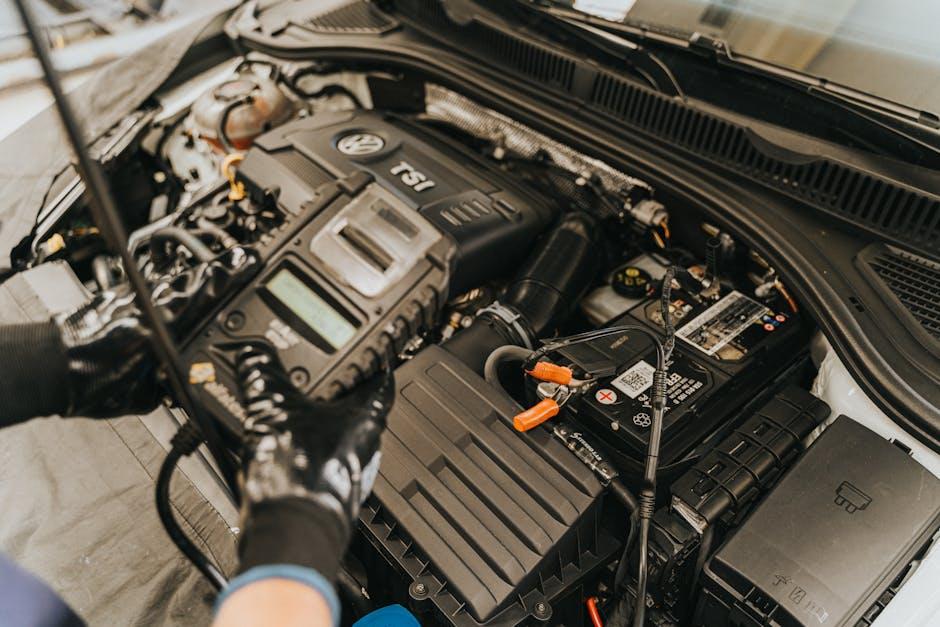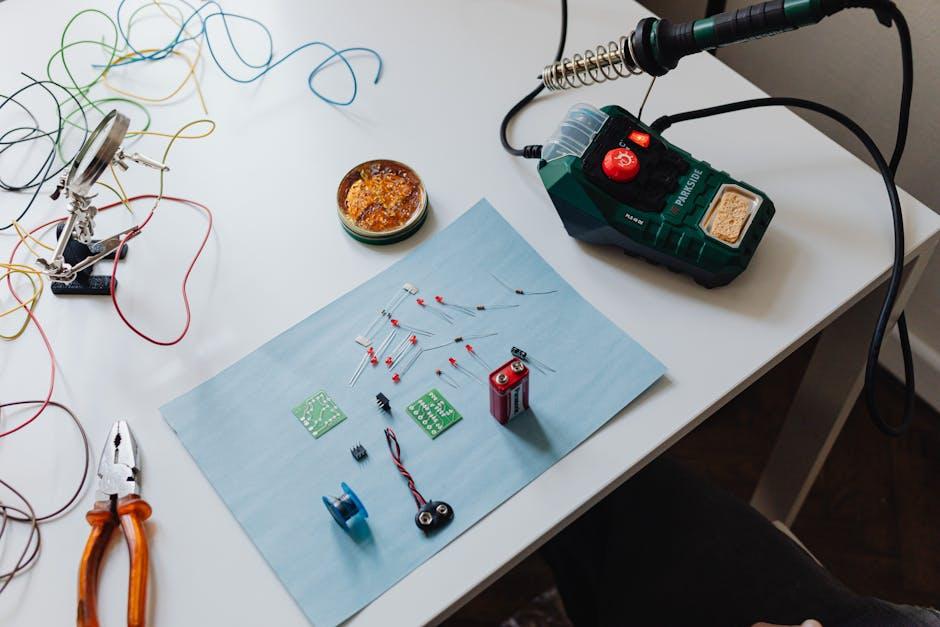In the intricate dance of modern technology, our devices often feel like energy-hungry companions—ever ready, yet sometimes mysteriously exhausted before their time. One common culprit behind these premature power losses is parasitic battery drain, a stealthy thief that saps life when your gadgets should be resting. Understanding how to identify and manage this subtle yet persistent drain is key to maximizing battery longevity and ensuring your devices perform when you need them most. In this article, we’ll unravel the concept of parasitic battery drain and guide you through practical steps to keep your devices charged and ready for action.
Table of Contents
- Understanding the Nature of Parasitic Battery Drain
- Identifying Common Culprits Behind Unexpected Power Loss
- Step-by-Step Diagnostic Techniques for Pinpointing Battery Issues
- Effective Tools and Equipment for Battery Drain Detection
- Practical Tips to Prevent Parasitic Drain in Everyday Driving
- When to Seek Professional Help for Persistent Battery Problems
- Q&A
- The Conclusion

Understanding the Nature of Parasitic Battery Drain
Parasitic battery drain refers to the slow discharge of a vehicle’s battery when the engine is off, caused by components that continue to draw power. Unlike normal battery use, which happens when the car is running and charging the battery, parasitic drain is an unwanted power loss that can leave you stranded with a dead battery. Common culprits include faulty electrical modules, glitches in aftermarket accessories, and even interior lights left on unintentionally. Understanding what triggers this silent energy leak is key to diagnosing and fixing it effectively.
To better grasp the issue, consider how various systems behave when the ignition is off:
- Alarm systems that remain active to protect your car
- Infotainment systems in standby mode, constantly drawing minimal power
- Electronic control units (ECUs) that enter sleep modes but may malfunction
- Accessories like GPS trackers or dash cams that sometimes operate around the clock
| Component | Typical Drain (mA) | Impact |
|---|---|---|
| Alarm System | 10-20 | Security but drains battery over time |
| Interior Lights | 100-200 | High drain if left on accidentally |
| Aftermarket Stereo | 30-50 | Can cause moderate drain if wired poorly |
| ECU Malfunction | Varies | Unpredictable battery loss |

Identifying Common Culprits Behind Unexpected Power Loss
Unexpected power loss in your vehicle’s battery is often the result of hidden energy drains that silently sap power when you least expect it. Common offenders include forgotten interior lights left on, faulty door switches that fail to shut off electrical circuits, and aftermarket electronics such as alarm systems or stereos that may continue to draw current even when the car is turned off. Additionally, a number of electronic control modules inside modern vehicles stay partially active to preserve settings or maintain readiness, contributing to the parasitic drain.
Understanding these culprits can be simplified by categorizing their typical impact on your battery’s health. Below is a quick overview:
| Culprit | Typical Drain Level | Solution |
|---|---|---|
| Interior Lights Left On | Moderate | Check all cabin lights, including glove box and trunk |
| Faulty Door Switches | High | Inspect and replace malfunctioning switches |
| Aftermarket Accessories | Variable | Unplug devices when not in use; have professional wiring check |
| Electronic Control Modules | Low to Moderate | Consult dealership or mechanic for module reset or upgrade |
- Short Circuits: Beware of damaged wiring harnesses creating unexpected drain.
- Old or Damaged Battery: Sometimes what seems like a drain problem is actually a sign of a failing battery.
- Glove Box or Trunk Lights: They often get overlooked but can create power loss if stuck on.

Step-by-Step Diagnostic Techniques for Pinpointing Battery Issues
Begin by isolating the drain to determine if the battery issue stems from parasitic consumption or general dysfunction. Start with a fully charged battery and use a multimeter set to measure current (amps). Disconnect the negative battery cable and place the multimeter leads in series between the battery terminal and cable. This setup allows you to detect any abnormal current draw when the vehicle is off. A typical parasitic drain should draw less than 50 milliamps, so readings above this threshold indicate something is drawing power unnecessarily. Be sure to let the car’s systems enter sleep mode, which can take up to 30 minutes, so you measure only the parasitic drain.
- Use a known good battery to rule out battery age or defect
- Check all interior lights, glove box, and trunk areas for dimly lit bulbs
- Inspect aftermarket electronics and wiring modifications
- Look up manufacturer parasitic drain specifications for your vehicle model
If a high drain is identified, employ a strategic fuse pull technique to pinpoint the culprit circuit. Starting with the main fuse box, pull out one fuse at a time while monitoring the multimeter reading. A sudden drop signals the responsible circuit. Once isolated, further narrow down the problem by checking each component powered by that circuit. This process avoids guesswork and provides a clear path to fixing the battery drain without unnecessary replacements.
| Step | Action | Expected Multimeter Reading |
|---|---|---|
| 1 | Connect multimeter in series to the negative terminal | < 50 mA |
| 2 | Wait until vehicle’s electronics sleep mode activates | Stable reading |
| 3 | Remove fuses one by one while observing meter | Drop in current indicates draining circuit |
| 4 | Inspect components on the flagged circuit | Identify faulty part |

Effective Tools and Equipment for Battery Drain Detection
Accurately identifying parasitic battery drain requires a selection of precise and reliable diagnostic tools. At the forefront is the digital multimeter, essential for measuring current draw with high sensitivity and pinpointing abnormal battery consumption. A multimeter’s ability to display real-time current values helps differentiate between normal and parasitic loads, especially during the vehicle’s off state. Additionally, a dedicated battery tester can assess the overall health of the battery, ensuring that observed drains aren’t simply due to an aging or faulty battery.
Beyond handheld devices, dedicated automotive power analyzers provide a comprehensive analysis by monitoring current flow over extended periods, detecting intermittent drains that might be missed with brief checks. For enhanced diagnostics, consider tools such as:
- Clamp meters for non-intrusive current measurements
- OBD-II scanners to retrieve vehicle electronics data
- Relay click testers to evaluate control circuits
| Tool | Primary Function | Key Benefit |
|---|---|---|
| Digital Multimeter | Measure current draw | High accuracy for drain detection |
| Battery Tester | Assess battery condition | Identify weak or failing batteries |
| Automotive Power Analyzer | Monitor current over time | Detect intermittent drains |
| OBD-II Scanner | Read electronic system faults | Pinpoint electrical anomalies |

Practical Tips to Prevent Parasitic Drain in Everyday Driving
Minimizing parasitic battery drain starts with developing smart habits during your daily routine. Always ensure that all interior lights and accessories—like the radio or phone chargers—are turned off when the vehicle is not in use. If your car is equipped with aftermarket electronics, such as alarm systems or additional lighting, have them professionally installed and periodically checked to avoid faulty wiring, which is a common culprit for energy loss. Carrying a portable battery tester or multimeter can help you quickly check your battery’s health before you hit the road.
Another savvy strategy is regular maintenance and inspection. Keep your battery terminals clean and free from corrosion, as even slight buildup can cause energy inefficiency. Consider scheduling a quick electrical system check during your vehicle’s routine service; this can uncover hidden draws from components like the ECU or sensors. Here’s a quick reference table to help you prioritize actions based on the potential impact of various parasitic drains:
| Source | Impact Level | Suggested Action |
|---|---|---|
| Interior Lights Left On | High | Double-check before exiting |
| Aftermarket Electronics | Medium | Professional installation & inspection |
| Faulty Wiring | High | Periodic electrical system check |
| ECU and Sensors | Low to Medium | Routine vehicle diagnostics |

When to Seek Professional Help for Persistent Battery Problems
If you find yourself constantly jump-starting your vehicle, or your battery drains faster than expected despite following typical preventive measures, it might be time to call in the experts. Persistent battery issues can signal deeper electrical faults that require advanced diagnostic tools and experience. Ignoring these signs can lead to frequent breakdowns or even damage to your vehicle’s electrical system, escalating repair costs.
Consider professional intervention when you notice:
- Battery drain persists despite replacing the battery and checking for common culprits.
- Unusual electrical behavior like flickering dashboard lights or malfunctioning accessories.
- Difficulty pinpointing the source of drain after your own troubleshooting attempts.
- Recurring warning lights on your vehicle’s display, suggesting battery or charging system issues.
| Symptom | Possible Cause | Why Professionals? |
|---|---|---|
| Rapid battery drain | Hidden electrical draw | Advanced circuit tracing tools needed |
| Flickering dashboard lights | Faulty wiring or alternator issues | Requires detailed electrical system analysis |
| Warning light stays on | Charging system malfunction | Specialized diagnostic equipment needed |
Q&A
Q&A: How to Deal with Parasitic Battery Drain
Q1: What exactly is parasitic battery drain?
A1: Parasitic battery drain is when your car’s battery slowly loses charge even while the vehicle is turned off. It happens because certain electrical components or systems continue to draw power, quietly siphoning energy and leaving you with a dead battery.
Q2: How can I tell if parasitic drain is the culprit behind my battery problems?
A2: If your battery dies after your car has been sitting idle for a day or two, it’s a likely sign. Other clues include dimming interior lights when the car is off, or needing frequent jump-starts despite a healthy battery and alternator.
Q3: What common parts cause parasitic drain?
A3: Devices like alarm systems, interior lights left on, faulty wiring, aftermarket accessories, or control modules stuck in ‘awake’ mode are usual suspects. Even a glove box or trunk light that won’t switch off can quietly munch away at your battery.
Q4: How can I check for parasitic battery drain myself?
A4: Use a multimeter set to measure current. Disconnect the battery’s negative terminal and insert the multimeter leads between the terminal and cable. When everything’s off, you should see a minimal draw (typically under 50 milliamps). If it’s higher, something’s gobbling up your power, and you’ll have to track down the cause by pulling fuses one by one until the draw drops.
Q5: What steps can I take to fix parasitic drain?
A5: After identifying the culprit, you can repair or replace faulty components, disconnect unnecessary accessories, or fix wiring issues. Sometimes, simply ensuring doors and glove compartments close properly to turn off interior lights solves the problem.
Q6: Can professional help be useful in these cases?
A6: Absolutely. Finding parasitic drains can be tricky and time-consuming. Mechanics have specialized equipment and experience to quickly pinpoint and repair problematic circuits if DIY methods feel daunting.
Q7: How can I prevent parasitic drain from happening in the future?
A7: Regular maintenance of electrical systems, turning off interior lights, removing unused accessories, and periodically checking battery health all help reduce risk. Also, consider investing in a battery maintainer if your car sits unused for extended periods.
Q8: Is parasitic drain harmful to my battery?
A8: Yes, prolonged parasitic drain can severely reduce your battery’s lifespan by causing deep discharges and frequent recharges. It’s best to address any drain issues promptly to keep your battery happy and healthy.
Parasitic battery drain might be invisible, but its effects can leave you stranded. With a bit of detective work and some preventative care, you can keep your battery charged and your journeys uninterrupted.
The Conclusion
In the quiet shadows of our devices, parasitic battery drain can stealthily steal precious power, leaving us stranded when we least expect it. But armed with understanding and a few thoughtful strategies, you can reclaim control and extend your battery’s life. Remember, vigilance and timely action are your best allies against the invisible energy thieves. So, next time your device’s charge seems to vanish into thin air, you’ll know exactly how to shine a light on the culprit—and keep your battery going strong.

